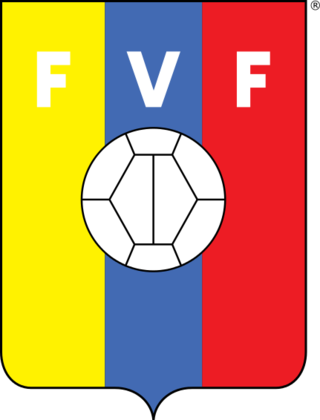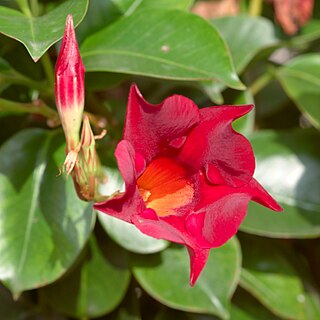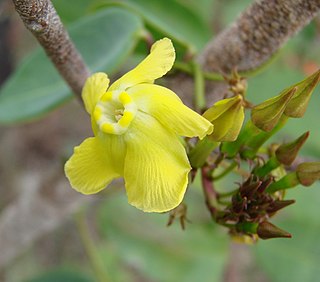
Classification of Indigenous peoples of the Americas is based upon cultural regions, geography, and linguistics. Anthropologists have named various cultural regions, with fluid boundaries, that are generally agreed upon with some variation. These cultural regions are broadly based upon the locations of Indigenous peoples of the Americas from early European and African contact beginning in the late 15th century. When Indigenous peoples have been forcibly removed by nation-states, they retain their original geographic classification. Some groups span multiple cultural regions.

Oncidium, abbreviated as Onc. in the horticultural trade, is a genus that contains about 330 species of orchids from the subtribe Oncidiinae of the orchid family (Orchidaceae). As presently conceived, it is distributed across much of South America, Central America, Mexico and the West Indies, with one species (O. ensatum) extending into Florida. Common names for plants in this genus include dancing-lady orchid and golden shower orchid.

The Bolivia national football team, also known as La Verde, has represented Bolivia in international football since 1926. Organized by the Bolivian Football Federation (FBF), it is one of the ten members of FIFA's South American Football Confederation (CONMEBOL).

The Venezuela national football team represents Venezuela in men's international football and is controlled by the Venezuelan Football Federation (FVF), the governing body for football in Venezuela. They are nicknamed La Vinotinto because of the traditional burgundy color of their shirts. When playing at home in official games, they usually rotate between three stadiums: The Polideportivo Cachamay in Puerto Ordaz, the Estadio José Antonio Anzoátegui in Puerto La Cruz and the Estadio Pueblo Nuevo in San Cristóbal. In friendly matches, they tend to rotate between the rest of the stadiums in the country.

Mandevilla is a genus of tropical and subtropical flowering vines belonging to the family Apocynaceae. It was first described as a genus in 1840. A common name is rocktrumpet.

Ponthieva is a genus from the orchid family (Orchidaceae). They are named after Henry de Ponthieu, an English merchant of Huguenot ancestry who sent West Indian plant collections to Sir Joseph Banks in 1778.

Weinmannia is a genus of trees and shrubs in the family Cunoniaceae. It is the largest genus of the family with about 150 species. It is also the most widespread genus, occurring in Central and South America including the Caribbean, Madagascar and surrounding islands, Malesia and the islands of the South Pacific. It is absent from mainland Africa and Australia, but some fossils have been attributed to Weinmannia in Australia. Leaves are simple or pinnate, with a margin usually toothed, and interpetiolar stipules. Flowers are bisexual, white, arranged in racemes. The fruit is a capsule opening vertically from the top to the base. Seeds hairy without wings.

Aegiphila is a genus of flowering plants in the mint family, Lamiaceae, first described in 1763. It was formerly classified in the Verbenaceae. It is native to Mexico, Central America, South America, the West Indies, and Florida.

Brunellia is a genus of trees. They are distributed in the mountainous regions of southern Mexico, Central America, West Indies, and South America. Brunellia is the only genus in the family Brunelliaceae. As of 2001 there were about 54 species.

Prestonia is a genus of plants in the family Apocynaceae, first described as a genus in 1810. It is native to Mexico, Central America, South America, and the West Indies. It is closely related to Artia and Parsonsia.

The Corporacion Andina de Fomento (CAF) – Banco de Desarrollo de América Latina (Portuguese: Corporação Andina de Fomento – Banco de Desenvolvimento da América Latina, is a development bank that has a mission of stimulating sustainable development and regional integration by financing projects in the public and private sectors in Latin America, and providing technical cooperation and other specialized services. Founded in 1970 and currently with 19 member countries from Latin America, the Caribbean, and Europe along with 13 private banks, CAF is one of the main sources of multilateral financing and an important generator of knowledge for the region.
Reina Hispanoamericana is an annual beauty pageant celebrating Hispanic heritage, language and culture, started in 1991 as Reina Sudamericana, is based in Santa Cruz de la Sierra, Bolivia. Up to 2003 the participants were restricted to the 10 countries in South America; in 2004 participants from Panama and Costa Rica in Central America were invited; and in 2006 participants from the Dominican Republic, Nicaragua, Puerto Rico, Portugal & Spain joined. In 2007 Mexico, Guatemala, Honduras & United States were added, and the name changed to Reina Hispanoamericana. In 2008, Curaçao and Haiti were added. In 2017, the Philippines, Canada, and Australia were added.

The Peru national football team has represented Peru in international football since 1927. Their first match came against Uruguay at the 1927 South American Championship. As of September 2019, Peru has played 645 matches with 212 wins, 157 draws, and 276 losses.
Cacographis is a genus of moths of the family Crambidae.
Cacographis macrops is a moth in the family Crambidae. It was described by Eugene G. Munroe in 1970. It is found in Bolivia.

This page details the match results and statistics of the Bolivia national football team from 2000 to 2019.
This article details the matches played by the Venezuela national football team from 2000 to 2019.
Reina Hispanoamericana 2021 was the 30th edition of the Reina Hispanoamericana pageant. It was held on October 30, 2021 in Santa Cruz, Bolivia. Regina Peredo of Mexico crowned Andrea Bazarte of Mexico as her successor at the end of the event. This marked Mexico’s first back-to-back victory in the pageant.












